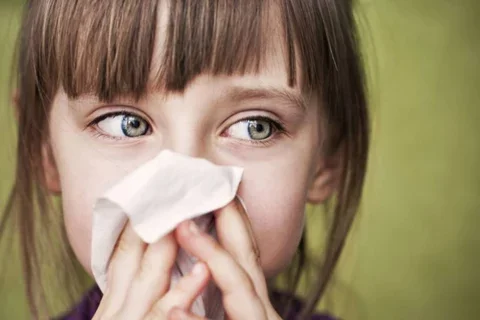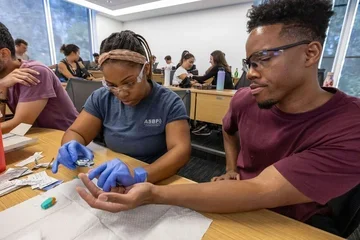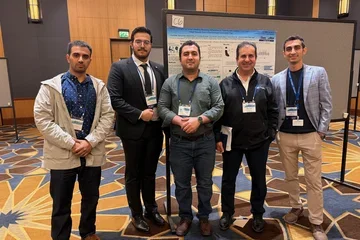Kids’ allergies may be worsened by recent SoCal rains
Advice for parents from a UCLA Health pediatric allergist

Record rainfall in Southern California has left children and young adults with allergies awash in symptoms worsened by wet, windy weather.
Maria Garcia-Lloret, MD, a UCLA Health pediatric allergist and immunologist, said light rain can clean pollution from the air and clear away pollen. But recent record-breaking rainfall has pummeled pollen into smaller particles that are more easily inhaled and reach deeper into the lungs.
“The symptoms have been more persistent and worse,” says Dr. Garcia-Lloret, professor of pediatrics at the David Geffen School of Medicine at UCLA. “Since October, there has been an increase in consultations for nasal congestion, runny nose and a cough that doesn’t go away. We have also noted an increase in asthma flares in patients who previously were well controlled.”
In addition to weather, another complication this allergy season has been the symptom overlap with a fall and winter higher-than-usual and more prolonged surge in upper respiratory illnesses, Dr. Garcia-Lloret notes.
“People come to me for allergies, but I keep an open eye for other possible causes of their symptoms,” she says. “Some kids have allergies, some have RSV or other viral infections, some maybe have both.”
Dr. Garcia-Lloret says it’s important to determine what is causing symptoms and provide proper treatment, especially since children with allergies have missed school out of an abundance of caution.
A perfect storm
Tree pollen, a common outdoor allergen in Southern California, is most prevalent from January through May. Severe storms, like those that have battered the region in recent months, turn larger pollen pieces into microparticles and transport them across wider areas, Dr. Garcia-Lloret says.
“By breaking down the little pollen particles they make them more dangerous,” she says. “These microparticles can travel faster with water, with winds.”
Research has shown that after thunderstorms, emergency rooms report an influx of patients with respiratory distress due to asthma.
“Bad rains can cause asthma attacks in allergy patients,” Dr. Garcia-Lloret says.
Asthma typically starts in childhood and can cause wheezing and difficulty breathing once airways become inflamed.
Studies on asthma attacks after storms have found that sometimes there can be a lag of a couple of days before flareups begin, Dr. Garcia-Lloret says.
“Each person might be a little bit different, with different sensitivity,” she says.
For people with allergies who don’t have asthma, breathing in more pollen can result in increased symptoms of nasal congestion, sinus pressure, post-nasal drip and coughing.
People with allergies may also be more susceptible to developing viral infections, which surged over the fall and winter in a combination of RSV in children as well as cases of flu and COVID-19.
Prevention and treatment
Dr. Garcia-Lloret recommends that parents of children with allergies take precautions for three to five days after heavy rain. She advises keeping windows closed, making sure hands are washed and bathing after spending time outdoors and potentially using a nasal saline wash to remove pollen that gets trapped in the nose.
“If there’s going to be a storm, try to stay home and close your windows,” she says. “Being informed, looking at the weather and pollen counts, might help.”
Dr. Garcia-Lloret says that allergies are treatable but not always curable. People with allergies often use an antihistamine and steroid nasal spray for relief.
This season, she’s noticed that symptoms have been harder to manage with the usual combination of medicines.
“The usual medicines that are used on an as-needed or permanent basis don’t seem to be enough,” Dr. Garcia-Lloret says. “If the medicines don’t work, we may have to increase the dose or add new ones. We also need to consider other causes such as sinus infections or bronchitis, which, in themselves, can present as complications of insufficiently treated allergies”
Dr. Garcia-Lloret says sometimes parents are reluctant for their children to take allergy medication, but she explains that they are safe, typically over the counter and in many cases, temporary.
“Medicine is not forever. It’s very dynamic,” she says. “I usually tell families that the objective of treating allergies is to make the patient comfortable and to prevent complications.”
Untreated allergies can also be a contributing factor in chronic headaches and fatigue.
“Allergies can be an annoyance, but an annoyance that sometimes leads to things you don’t necessarily associate with allergies,” Dr. Garcia-Lloret says. “If you can’t really breathe through your nose or you itch, you really don’t sleep well. Sleep is critical for our wellbeing and executive function.”
Monitoring of symptoms is important, she says. While children or young adults may initially receive treatment from a pediatrician or primary care doctor, if symptoms persist or worsen an allergy evaluation is needed. That ranges from blood tests to skin testing which are typically performed by an allergist.
Dr. Garcia-Lloret says she expects for allergy conditions to return to a baseline level after spring rains subside and tree pollen decreases in June.
“What was unusual in the season was the combination of more respiratory infections and more rain on top of what is historically the worst pollen season in Southern California,” she says.
Courtney Perkes is the author of this article.
Take the Next Step
Learn more about UCLA Health's Pediatric Allergy and Immunology program.
Original Article: "Kids’ allergies may be worsened by recent SoCal rains"



